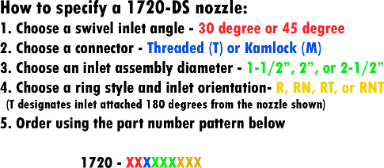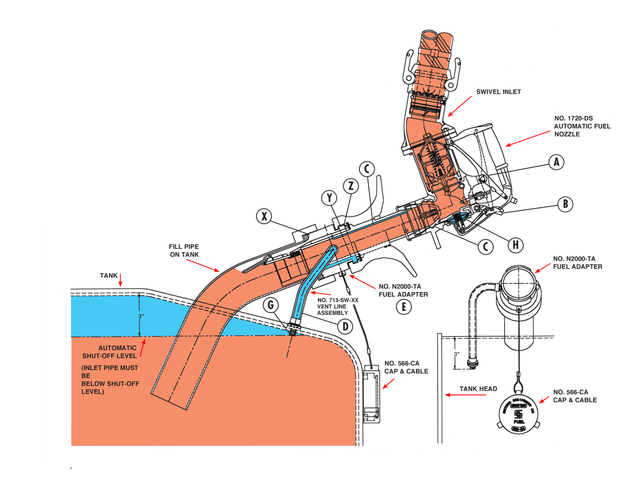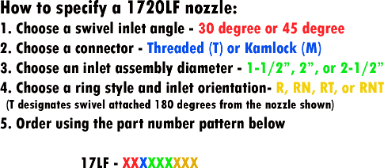Fuel Nozzles
Snyder 1720-DS fuel nozzles – Setting the fueling standard in the rail industry for over 40 years.
The Snyder 1720-DS nozzle combines high flow rates with an automatic shutoff feature, allowing efficient fueling with minimum need for operator control.
The 1720-DS nozzle is designed for flow rates between 100-380 GPM. To ensure automatic shutoff at lower flow rates (20-100 GPM), Snyder recommends the 17LF fuel nozzle.
Example: Nozzle shown is 1720-30M2.5RN (standard nozzle, 2-1/2" inlet at 30 degree angle, Kamlock, wheel ring style)
The Snyder II Automatic Fueling System works on a vacuum principle. The system consists of a Snyder 1720-DS Automatic Nozzle and N2000-TA Fuel Tank Adapter Vent Assembly (D and E).
When the automatic nozzle lever (A) is opened, diesel fuel flows through the nozzle and across an internal venturi (C) where a vacuum is created. Diesel fuel flowing into the fuel tank fill adapter (E) draws air from the locomotive fuel tank through the vent line (D) and into the tank adapter (E). Air is then circulated through the internal vacuum tube of the nozzle spout reaching the venturi (C) to satisfy the vacuum, thereby keeping the nozzle open.
As the level of diesel fuel rises in the fuel tank, it will cover the tip (G) of the fuel tank vent line stopping the entry of air into the tank adapter (E). With the absence of air to satisfy the vacuum at the venturi (C), the vacuum activates the automatic shut-off mechanism (H) which releases the operating lever (A) and closes the nozzle.
1720 LF Information
Snyder 1720-LF fuel nozzles – Designed for low flow rate applications
Snyder 1720-LF nozzles are modified versions of the 1720-DS nozzle, designed for flow rates between 20-100 GPM while maintaining automatic shutoff.
Typical uses are DTL (Direct Truck to Locomotive) applications or fixed locations with low flow rates.
Example Shown: Nozzle is 1720LF-30M2.5RN (standard nozzle, 2-1/2" inlet at 30 degree angle, Kamlock, wheel ring style)
Re-Qualified Nozzles
The following parts and or services will be performed on ALL 1720-DS and 1720LF nozzles when participating in the re-qualification program:
- Inner Assembly (Upgraded to aluminum)
- Gaskets (new)
- Packing (new)
- Fulcrum Lever (new or re-qualified)
- Bleeder Poppet (new or re-qualified)
- O Rings (new)
- Diaphragm Assembly (new)
- Latch Assembly (new or re-qualified)
- Lever Assembly (new or re-qualified)
- Swivel Inlets (new or re-qualified)
- Handle (new or re-qualified)
- Ring (new or re-qualified)
- Seat Ring (new)
- Springs (new)
- Spout Adaptor (new or re-qualified)
- Tail (new or re-qualified) (critical when using with new 2000-TA adaptors)
- Nozzle Strainer (new or re-qualified)
- Body (new or re-qualified)
All items in bold, considered major components. Any nozzle that requires replacement of four (4) or more major components will be deemed beyond repair.
All nozzles will be pre-cleaned, visually inspected, and pre-tested. A complete tear down will then be performed, and all hard parts will be glass bead cleaned, and qualified. The nozzles will be re-assembled, tested, flushed, and packaged for shipment.
Re-qualified nozzles will carry a one (1) year limited warranty from date of shipment.
FAQS
Got questions? We’ve got answers.
- Why does my nozzle work on some locomotives and not others?
Snyder nozzles work on a vacuum principle. A proper air supply is important to maintain standard operating vacuum, and a high vacuum is necessary for automatic shutoff when the tank fills. Most nozzle problems are related to the air supply – there isn’t enough air to create operating vacuum during operation, or there’s an air leak.
An individual locomotive may be allowing air leaks or restricting the normal flow of air if the tank adapter or vent hose is damaged or improperly installed. This can result in nozzles shutting off prematurely or failure of the automatic shutoff.
Learn more about the air supply and its effects here (NOZZ-MAN-1006)
- Why won’t my 1720-DS nozzle shut off?
Problem:
Low fuel flow – not enough force to create an operating vacuum.
Solution:
Increase flow to recommended range or change to 1720-LF.
Problem:
Vent hose leak.
Solution:
Tighten hose fittings or replace hose with a Snyder vent hose.
Problem:
Damaged adaptor surface is leaking.
Solution:
Replace the Fuel Tank Adaptor.
Problem:
Damaged or missing FR-65 gasket.
Solution:
Replace the FR-65 gasket.
Problem:
Loose coupling ring allowing air leak.
Solution:
Tighten the coupling ring or send in for repair.
Problem:
Flooded Diaphragm.
Solution:
Manually press the diaphragm lever (latch) 3-4 times to clear.
- Why won’t my 1720-DS nozzle stay on?
Problem:
Incorrect vent hose fittings creating a restriction.
Solution:
Replace with a Snyder vent hose.
Problem:
Sagging fuel line trapping fuel and restricting air.
Solution:
Reinstall vent line correctly.
Problem:
Plugged main air passage in nozzle.
Solution:
Clear restriction in main air passage tube.
Problem:
Tank adaptor not oriented properly causing fuel splashback into air supply.
Solution:
Orient adaptor per instructions with hinge at 12 o’clock
Problem:
Bent lever/stem or damage.
Solution:
Send nozzle in for repair.
Problem:
High pressure or excessive system pressure spikes.
Solution:
Reduce pressure. Check thermal relief of fueling system. Utilize or service surge suppressor.
- Why won’t my 1720-LF nozzle shut off?
Problem:
Very low fuel flow – not enough force to create an operating vacuum
Solution:
Increase flow to recommended range
Problem:
Vent hose leak.
Solution:
Tighten hose fittings or replace hose with a Snyder vent hose.
Problem:
Damaged adaptor surface is leaking.
Solution:
Replace the Fuel Tank Adaptor.
Problem:
Damaged or missing FR-65 gasket.
Solution:
Replace the FR-65 gasket.
Problem:
Loose coupling ring allowing air leak
Solution:
Tighten the coupling ring or send in for repair.
Problem:
Flooded Diaphragm.
Solution:
Manually press the diaphragm lever (latch) 3-4 times to clear.
- Why won’t my 1720-LF nozzle stay on?
Problem:
Flowrate too high
Solution:
Decrease flow to recommended range or change to 1720-DS.
Problem:
Incorrect vent hose fittings creating a restriction.
Solution:
Replace with a Snyder vent hose
Problem:
Sagging fuel line trapping fuel.
Solution:
Reinstall vent line correctly.
Problem:
Plugged main air passage in nozzle.
Solution:
Clear restriction in main air passage tube.
Problem:
Tank adaptor not oriented properly causing fuel splashback into air supply.
Solution:
Orient adaptor per instructions with hinge at 12 o’clock.
Problem:
Bent lever/stem or damage.
Solution:
Send nozzle in for repair.
Problem:
High pressure or excessive system pressure spikes.
Solution:
Reduce pressure. Check thermal relief of fueling system. Utilize or service surge suppressor.
- What’s the difference between FR65 and B06 gaskets?
- How do I specify a nozzle for my application?
Snyder 1720-DS nozzles are designed for flow rates of 100 – 380 GPM, while Snyder 1720-LF nozzles are designed for 20-100 GPM. The recommended operating pressure range is 45-65 psi, but this may vary depending on individual fueling layouts. Designers should compensate for enough losses in the system to allow a minimum of 45 psi operating pressure.
For flow rates near 100 GPM, the decision depends on available pressure. If manual shutoff is acceptable, the 1720-DS is the better choice. If automatic shutoff is required, the 1720-LF is best, but it will require a sufficient pump to supply the higher pressure required to acheive 100 GPM. Pressure vs. flowrate curves are supplied in the manual for each model.
- How do you install a FR-65 gasket?
- Can I requalify my nozzle?
Yes, Snyder can requalify both 1720-DS and 1720-LF nozzles. Contact us to receive an RMA number and initate the return process. See the Requalfied Nozzle section for details on the requalification process
- Why does my 1720-DS nozzle drip after shutoff?
When the nozzle shuts off, the remaining material in the nozzle tail will drain into the tank within a few seconds. There is a small upper section that drains slower becuase it has to navigate a small opening around a poppet valve. Snyder recommends leaving the nozzle in the tank for several seconds to allow the tail section to drain, and promptly placing the nozzle into the fuel crane drain pan to catch any remaining slow drips.
Excelling Worldwide Since 1936
We are available via fax, email or telephone
Call
417-725-4067
All Rights Reserved | Snyder Equipment, A Division of New York Air Brake LLC
4654 W Junction St, Springfield, MO 65802 | Ph. (417) 725-4067 Fax (417) 725-4846


























